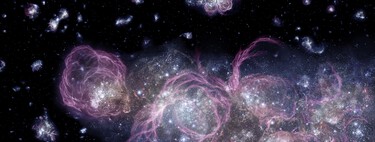Since the James Webb Space Telescope opened its infrared eyes to the universe, the truth is that everything beyond our atmosphere has gone from being something quiet and unknown to becoming a frenetic puzzle for all astrophysicists. Their latest discovery points to the oldest supermassive black hole ever detected, something that gives us more data about the origin of the universe.
It has arrived to break the mold. This black hole is located in the GHZ2 galaxy, and its most relevant information is not that it is really far away, but rather when it formed. Approximations place it just 350 million years after the Big Bang. Something that breaks the classic schemes that experts used, since in theory there would not have been enough time for a gravitational monster of that caliber to grow so much.
His discovery. As we say, the protagonist of this story is the GHZ2/GLASS-z12 galaxy. A discovery that has been made thanks to observations by JWST and the ALMA radio observatory in Chile, which has confirmed its location through different parameters that place it as the most distant and oldest structure that has ever been confirmed.
But what has set off alarm bells is not only its distance, but also its composition, since extremely intense ionized carbon emission lines have been detected.
To understand the importance of this finding, you have to know that ionizing carbon at these levels requires a large amount of energy. This means that younger and more massive stars have the capacity to do so, but it is not enough to explain the intensity that has been observed in this galaxy. This means that we have to point to an Active Galactic Nucleus, that is, a supermassive black hole that is swallowing matter at a frenetic pace.
The time problem. The study suggests that this black hole would have an enormous mass compared to its host galaxy. While in the local universe (ours) the ratio between the mass of the black hole and the stellar mass of the galaxy is around 0.1%, in GHZ2 this ratio could shoot up to 5%. This is something that challenges training theories that are currently divided into two camps:
- Light seeds: black holes are born from the death of the first stars and grow little by little. The problem here is that 350 million years is not enough to reach this size.
- Heavy seeds: huge clouds of primordial gas have collapsed into black holes to form them, but without becoming a star.
The finding of GHZ2 points directly to the second option or to “super-Eddington” feeding episodes (eating faster than radiation pressure theoretically allows).

Its importance. If this finding is finally confirmed, we would be facing the absolute record for an active supermassive black hole. Until now, this record was in the UHZ1 galaxy about 470 million years after the Big Bang. But now GHZ2 pushes us more than 100 million years back in time, bringing us dangerously close to the very moment it all began in our universe.
What really seems clear is that the universe in its beginning was not a boring or slow place. It was a dynamic, violent and rapid time where galaxies and black holes evolved at a great speed that we are now beginning to understand.
Images | BoliviaIntelligent
In WorldOfSoftware | Bad news, the Universe has entered its dying phase. Good news, we won’t be here to see it












